Ah, GenCon! For those of us who enjoy our gaming on the tabletop, there really isn’t a bigger convention and expo show than this one. Every year publishers big and small bring their upcoming titles to reveal, demo, and sometimes sell before they hit the market fully. Because many of these games will slowly emerge on the market over the next few months, a pretty common tradition is to look over the list of titles compiled by folks (this time, we’re referencing the excellent list compiled over at Board Game Geek, which you can find here) of games that will, in some form, be present at GenCon. Some of these titles will be for sale, some are getting their official announcement, and others are being demo’d for sale a little later this year (or next).
With that in mind, your trusty board gaming guide Marcy is here to list the 10 games out of the more than 500(!) at the event which I think it’s worth keeping an eye on. Please note that this is a list of the games that I am most excited to play and try, with some being simply prototypes, and others releasing fully AT GenCon, so much of this is based off of developer previews, rulebook reads, and other materials. These are not reviews, but a list of the ten games that we’re excited about the possibility of playing!
- The Yawning Portal: A Dungeons & Dragons Strategy Board Game (Avalon Hill)

To start off our list, we have a game for which only scant details have been revealed. The demo of this game’s prototype will be on display at Gencon and the reason it makes the list is that the continued popularity and growth of Dungeons and Dragons has led to some fun, interesting, and at least somewhat experimental game releases. WizKid’s recent release of Dungeon Scrawlers: Heroes of Undermountain had some really interesting ideas, if somewhat imperfect implementation. Taking risks with Dungeons and Dragons beyond TTRPGs is really great to see, and Yawning Portal’s theme–an inn of the same name where players will take on the role of servers competing for victory points while serving food–sounds like a fun and accessible title for D&D groups, family game nights, and more. Obviously, we’ll need to see more of the game before this really goes into the bargain bin of curiosity or not, but the concept is enough to make it onto our list. At the very least, this one caught my eye for the really interesting theme: Instead of another “Dungeons and Dragons, but a BOARD GAME,” this one takes some of the wacky ideas and concepts Dungeons and Dragons promises, and channels them into a different outlet.
- Tokaido Duo (Designer: Antoine Bauza, Artist: Xavier Gueniffe Durin, Publisher: Funforge)
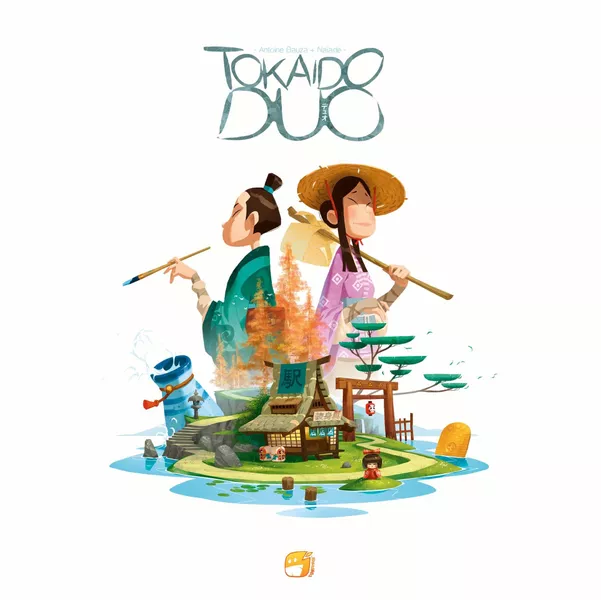
Tokaido is perhaps one of the most interesting ‘entry-level’ board games I’ve ever encountered. The main concept of the game – walk around Japan and supposedly just take in the sights – is somehow the most knives-out board game I can think about playing. Even amongst gaming groups that didn’t like conflict, I was shocked when they’d suggest Tokaido. This is especially true at two, in which Tokaido becomes an exercise in not playing to win but playing to prevent your opponent from winning. To put it bluntly, Tokaido is a painful game, and can become an extremely sour experience for a game that, ostensibly, should be very “Zen”. Tokaido Duo, on the other hand, seems to solve some of these issues by turning Tokaido into a two-player only game, similar to 7 Wonders Duel. The non-prototype version of this game was shown off a few days ago, so there’s not a whole lot of information to work off of yet, but based on how the game is laid out (with players not forced into the position the base game of Tokaido puts you in – one of cutting off your nose to spite your face), this might not just be an amazing 2-player entry-level game, it may actually turn out to be more enjoyable and relaxing than Tokaido itself. I will take a moment to say that I’ve always found the aesthetics of Tokaido to be a little bit… Orientalist, to put it politely, an issue that many board games set in Asia tend to have, and one that this version of Tokaido does not seem to really rectify. If that turned you off of the original, that’s likely to still be a problem here.
- Twilight Inscription (Designer: James Kniffen, Artists: Anders Finer, Tomasz Jedruszek, Alex Kim, Stephen Somers, Publisher: Fantasy Flight Games)
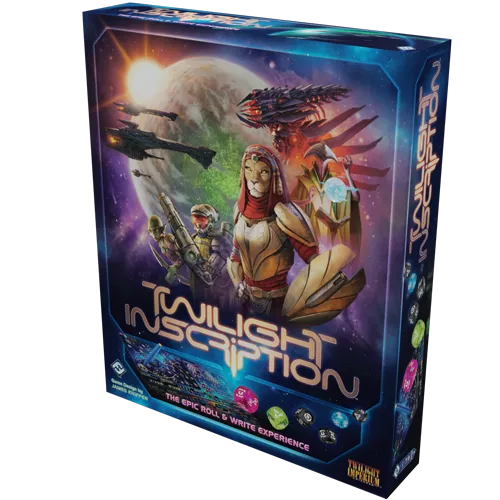
Twilight Inscription is the Roll and Write game set in the Twilight Imperium universe, and is designed by James Kniffen, who many 40k board gamers may know as the man behind Forbidden Stars. That alone was enough to put this game on the list, but frankly I’m just absolutely invested in the idea of turning Twilight Imperium into a Roll-n-Write, especially as it boasts playability for 1-8 players, with an estimated playtime of 90-120(!) minutes, which sounds either insane or amazing. There are scant details about how the game actually functions, and most of the materials available for the game currently are, well, not in English, so I have yet to see anything about how the game works, or how good (or, well, not good) it actually might be.
So why am I excited about the game, above others? Because Twilight Imperium is a huge title, and for many people, is the ‘biggest’ board game they ever played (or, at least, say they’ve played; I mean, have you seen how long it takes to actually play that game?), and Kniffen hasn’t really done much in the realm of board games lately, so if anyone can make this idea work, I have to believe it would be him. Either way, I think Twilight Inscription is going to be a game to watch; while people initially treated roll-n-write games as a ‘fad’, they do something that many other games don’t: Distill board games into small, manageable packages that play quickly, repeatedly, and provide great accessibility for players of various skill-levels and interest in the hobby. Seeing one of the nerdiest, most exclusionary of titles go down that path will either be a shining star, or the lights over the sewage treatment plant from Christmas Vacation.
- Planted (Designer: Phil Walker-Harding, Publisher: Buffalo Games)
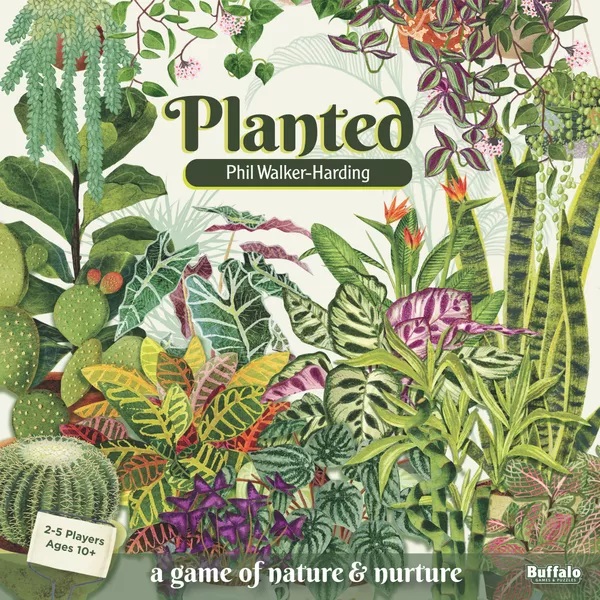
Barenpark is one of my household’s favorite games, and Phil Walker-Harding has designed quite a few games I’ve played at board game nights and had a lot of fun with (Sushi Go, the Adventure Game series, Imhotep) which tend to border on being easily accessible entry-level games but don’t overstay their welcome and provide a fun time for all. Perhaps like many of you, the pandemic has led you to an interest in household plants and care, and Planted’s theme really speaks to that, featuring common (and uncommon) household plants that players are going to work to take care of in order to obtain victory points over a series of rounds. Much like Sushi Go, players draft cards, taking a card and then passing the rest, with each player trying to construct a tableau of their own in pursuit of various scoring goals. Players collect Tools, Decorations, and Resources, which enable various avenues to accruing victory points. The theme here is a little bit aesthetic over mechanic, but the art on Planted looks charming, and the familiarity many players (and their families and friends) likely have with various house plants makes this a really attractive and accessible designed game.
Walker-Harding’s games tend to be very family-friendly and sit on the cusp of entry-level/mid-level gaming, meaning that there’s a good amount of crunch, but not too much to take away from the relaxing vibes the game gives off. Also, the components of this game look absolutely gorgeous, and for the MSRP the game is listed at (29.99 US), might mean that board gamers may have to start asking harder questions as to why they’re paying so much for games with less nice components!
- The Red Burnoose: Algeria 1857 (Designers: Matt Shoemaker and Roberta Taylor, Artist: Ahcene Blibek, Publisher: Hit ‘Em With a Shoe)
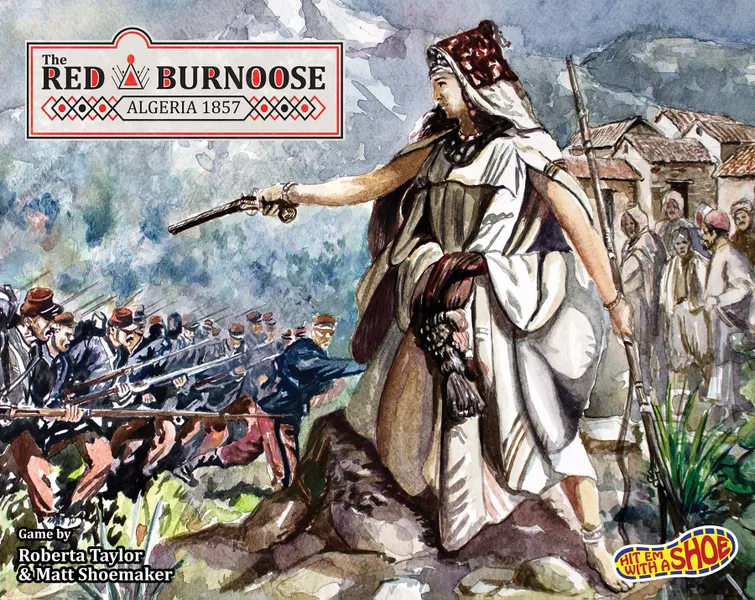
As our list goes a little deeper, this game snuck onto my radar for GenCon and is a game I’m personally dying to get my hands on. The Red Burnoose is a cooperative wargame that uses deckbuilding as its main mechanic. The idea–that players are working together (1-4 players) against the game itself–really caught my eye. The historical element, detailing France’s invasion of Algeria, has players taking on the role of various Algerian villages to stave off and defeat the French army, and is the type of deeply historical game that I truly love. This game could have any other theme–space aliens being fought off, monsters, zombies–but instead it uses a lesser-known historical period and gives players the uphill battle of fighting off a well-known, real historical monster: Colonialism. Perhaps the mechanical part of this game that really caught my eye from early prototype builds is that the French are an Automa deck, the style one might normally find in solo mode games (and, frankly, one finds very frequently in CONSIM games).
While I’ve always really liked the idea of Automa and how they create unique solo modes, this use of it as a main, neutral antagonist for players to fight against is something I’d like to see more of. I love historically themed games that are respectfully done and find the use of games to teach history a vastly overlooked tool, even amongst adults, so I’m really interested in not just playing Red Burnoose, but I’d love to see more historical wargames take similar periods and use this unique deck building ‘cooperative’ playstyle.
- Founders of Teotihuacan (Designer: Filip Glowacz, Artists: Chuy de Leon, Odysseas Stamoglou, Aleksander Zawada, Publisher: Board&Dice)

Publisher Board&Dice are the winner of our coveted “Same Publisher Manages to Get Two Games on Top Ten List” award, which isn’t real, but, well, it should be. Anyway, Founders of Teotihuacan caught my eye because of the way it takes the established themes of the Teotihuacan series of games and merges in some new ideas. The use of polyominos in the mix is what really drew my eye to this game, as I love the use of them in various tile laying games, but find that in games such as Barenpark, even though they’re fun, can be a little simplistic. The idea of combining some of that with a puzzlier aspect that also comes with certain levels of action selection has me really interested in see what the combo can do. The game is developed by someone other than the usual Daniele Tascini, but based on some of the previews and materials available, seems like it takes some of the spirit of the original game and reimplements it in interesting ways. Also, while Teotihuacan is a visually impressive game, it can also be a little heavy and complex, making it a medium-weight game that can overwhelm newer players. My ideal reality for this game, honestly, is that it serves as an introduction to trying to play the other game. Also, I’m dying for a slightly more complex game using polyominos, so this one seems like a slam dunk for me. However, I don’t think it is quite the gem that the other Board&Dice game is that’s also making a debut at Gencon, which is a little further down our list.
- Great Western Trail: Argentina (Designer: Alexander Pfister, Artist: Chris Quilliams, Publisher: eggertspiele)
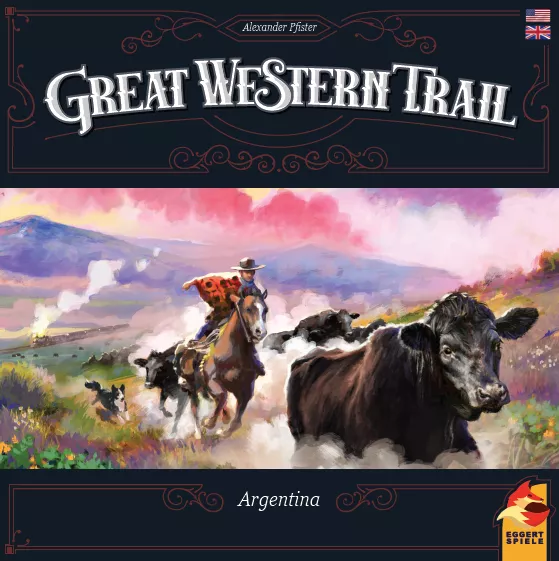
Great Western Trail is one of my favorite games. It features a fun worker placement system that culminates in slight deck-building and set collection of cows, and has an interesting spin on ‘Western’ as a theme–rather than cowboys shooting and robbing, you’re literally cowboys in the sense that you, well, travel around with cows to sell them for money. The game was recently re-released with an updated set of polish, taking out some of the somewhat… unfortunate aspects (such as the “Indians” who “Took your money”, i.e. robbed you. They robbed you), and more pleasant quality of life changes (like giving your meeples cowboy hats). However, I wasn’t really sold on upgrading. While the new coat of paint really helped some of the questionable aspects, the game itself remained basically unchanged, so it felt like double dipping for aesthetics on a game I already owned, and the expansion wasn’t out yet either. However, it turns out that the re-release of GWT was part of a trilogy, and the first new game in the series, Argentina, will be making its debut at GenCon. Although it doesn’t seem like it will be released for sale at the convention, the game is going to make an official debut, and I for one am really excited.
This excitement comes with some slight tempering; I haven’t always enjoyed Pfister’s designs (I bounced off of Maracaibo pretty hard), so mostly I am excited for the POTENTIAL of Argentina to continue the great magic of Great Western Trail. The fact that there is another game down the line, and the original GWT expansion is also getting rereleased means that I may now update my older copy, if only to have the full, new trilogy versions of the game. I’m also hoping that Argentina continues the tradition of a fairly fun solo mode, and also that the game will hopefully be great fun at 2 like the original is. Either way, I’m excited to rustle up some more cows for victory points; if you’re curious, I greatly recommend the original game as a great middle-weight worker placement game. It is a little dense, but actually flows very easily once you get the hang of it.
- Terracotta Army (Designer: Przemyslaw Fornal, Adam Kwapinski, Artists: Zuzanna Kolakowska, Jan Lipinski, Aleksander Zawada, Publisher: Board&Dice)

Terracotta Army being on this list might not surprise those Turn Order readers who are very much into the board game sphere. I think it is, pound for pound, the game I have seen the most on Top 10 lists for GenCon, and our list is no different in this regard. It isn’t number one, solely because it isn’t the game I’m most excited for, but it is certainly up there on our list. Board&Dice made a name for themselves in developing somewhat complex worker placement games that have engaging and unique historical themes, and Terracotta Army continues that trend. Something that I’ve always appreciated in their designs are the ways in which they do not fetishize or turn these historical themes into simple window dressing; the team seems to be committed to using their settings thematically and respectfully, which I have great respect for.
But what makes Terracotta Army so interesting, that almost every gaming outlet is slavering to get a hold of it? Well, 1-4 players will compete in a Worker Placement style game to contribute to the construction of Emperor Qin Shi Huang’s Terracotta Army. Aside from the variable worker placement choices that are presented, players also have to contend with a dynamic board in which miniatures are placed to construct and represent the famous army itself. The placement of these soldiers is what makes Terracotta Army so interesting to me (and, apparently, many others): rather than worker placement that just devolves into ‘I go here, I take this, I get 5 points,’ Terracotta Army’s added twist of strategic placement and construction of the actual army to accrue Domination and Presence on the board makes it visually and mechanically engaging. This is certainly a heavier game than some of the others on the list but has such a rich visual and mechanical theme that it really does seem impressive on the table as well. I love Worker Placement games, and often find them wonderful to play at variable player counts too, so I can’t wait to try this one.
- USPS: The Great American Mail Race (Designer: Ed Naujokas, Artist: Zoe Lee, Publisher: Big Potato)
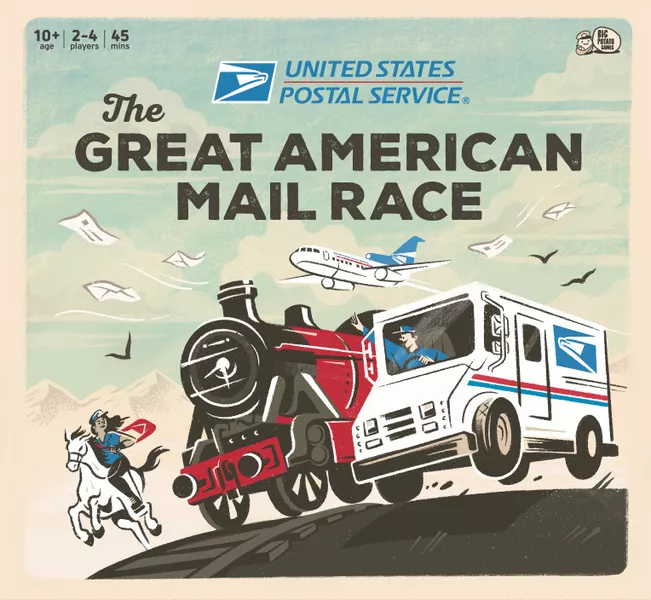
As I mentioned above, this girl LOVES Theme. I’m a Dramatic Thematic (Idiotic) Critic. But, really, board games tend to boil down to their mechanics. Oh, worker placement. Oh, trick taking. Ah, set matching. Aha, tile laying. You see what I mean? After a while the systems of games start to repeat on themselves in ways that don’t always get a gal going. But what does it for me is thematic games. USPS: The Great American Mail Race caught my eye on the list for theme alone. Looking into the game, a few unboxings of early copies showed so much love and care into the theme that it actually borders a little bit on campy: Rules come in an old-timey red/white/blue letter styled format, and the game even contains a stamper to mark off scoring objectives much akin to the types of hand-stampers you’d see at your local post office. The game also pays homage to the various forms of mail delivery over the decades, including pony express, hot air balloon, and modern mail trucks. The aesthetics of this game are choice, by the way: lots of lovely art and design choices (both artistic and ‘narrative’, such as including some of the most bizarre named towns in the United States).
The game also has some interesting mechanics, such as giving players 3 actions that can be divided (Draw 0, Play 3, Draw 2, Play 1, etc.), and features a sort of pick-up and deliver race, with players competing to deliver mail. There are even a few little ways to interfere with other players that are–again–thematic, and seem more fun than ‘take that’. I’m quite excited for USPS, and I think it will be a great addition to many gamer’s collections: simple, fun theme, simple mechanics, and a game that doesn’t seem to overstay it’s welcome. It isn’t the most complex game, but one that looks fun to break out with friends and family for board game night.
- Clank! Catacombs (Designer: Paul Dennen, Artists: Clay Brooks, Anika Burrell, Nate Storm, Dan Taylor (II), Publisher: Dire Wolf)
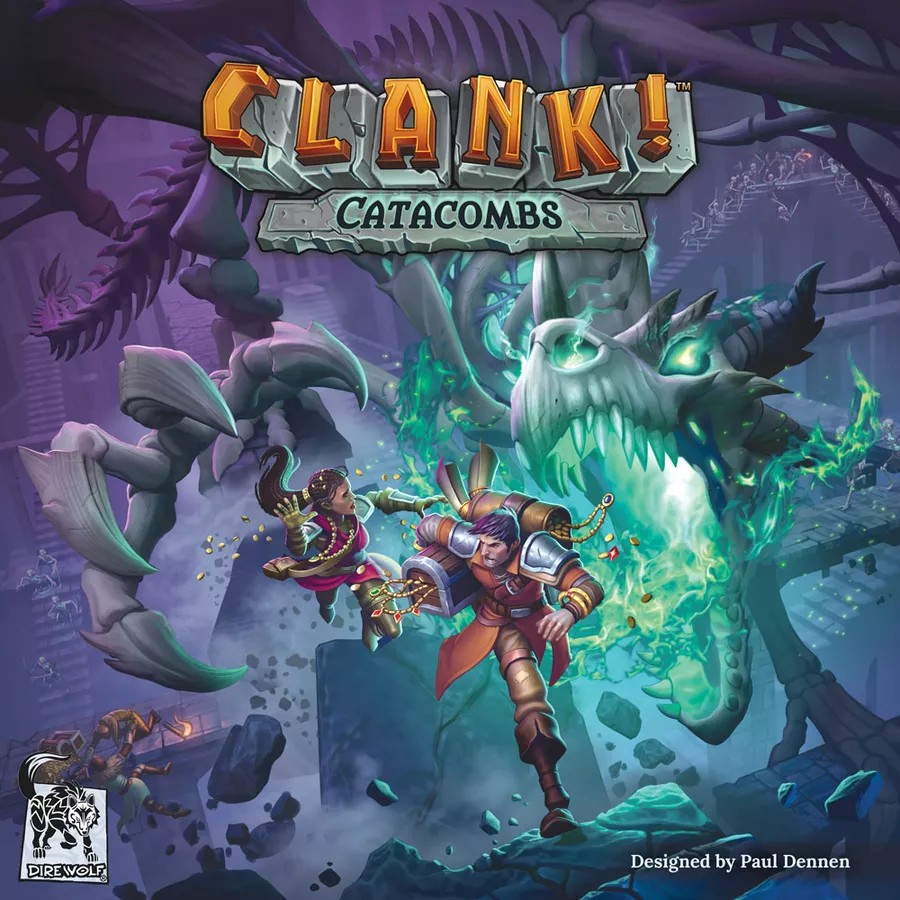
Clank! Is one of my favorite deck-building games ever. I absolutely loved all the time I spent playing Clank! Legacy, and the base game of Clank is also a blast. The idea of exploring a map while collecting cards for your deck, fighting monsters, and stealing treasure is so fun–and, oddly, either cooperative or cut-throat!–that it brings the added interactive element that many deck-building games lack. So, when I heard of how Clank! Catacombs will feature various dungeon tiles that can be shuffled and assembled to create different maps each time you play is the type of variability I crave in a game like Clank!, because not only does the deck shift and change, but the way players put the board together will change each time too.
If this is your first encounter with the series, Clank! tasks players with delving into caverns and dungeons in search of treasure (victory points), using a deck of cards they construct from a shared market. Along the way, players fight monsters, and generate “Clank”, or noise, which culminate in cubes being added to a bag, and players drawing from said bag whenever Dragon Attacks are triggered. This push your luck element is what leads to the cooperative competitive tension in Clank!, as ALL players who have generated Clank are at risk of suffering the wrath of the dragon and dying before you get back to the ‘safe’ parts of the map means you don’t get any points at the end!
Although I am a little sad that this isn’t another Legacy outing (I REALLY loved Acquisitions Incorporated and hope to see a second one someday), I’ve been honestly craving a new injection of Clank! into my life, and Catacombs seems like the game that will do exactly that. Also, as with other versions, the game is advertised to work with your existing Clank! Decks and expansions, meaning that even if you do get tired of the deck of cards included, you can mix and match it with other versions of the game (including Legacy, for those that didn’t know–you get a functional game of Clank! at the end of it!). Clank! is a fantastic series, and Catacombs is absolutely a must get for anyone who enjoyed previous ones, or wants a fun, exciting deck-building push your luck game, and easily makes it to the top of my list.
Have any questions or feedback? Drop us a note in the comments below or email us at contact@goonhammer.com.


